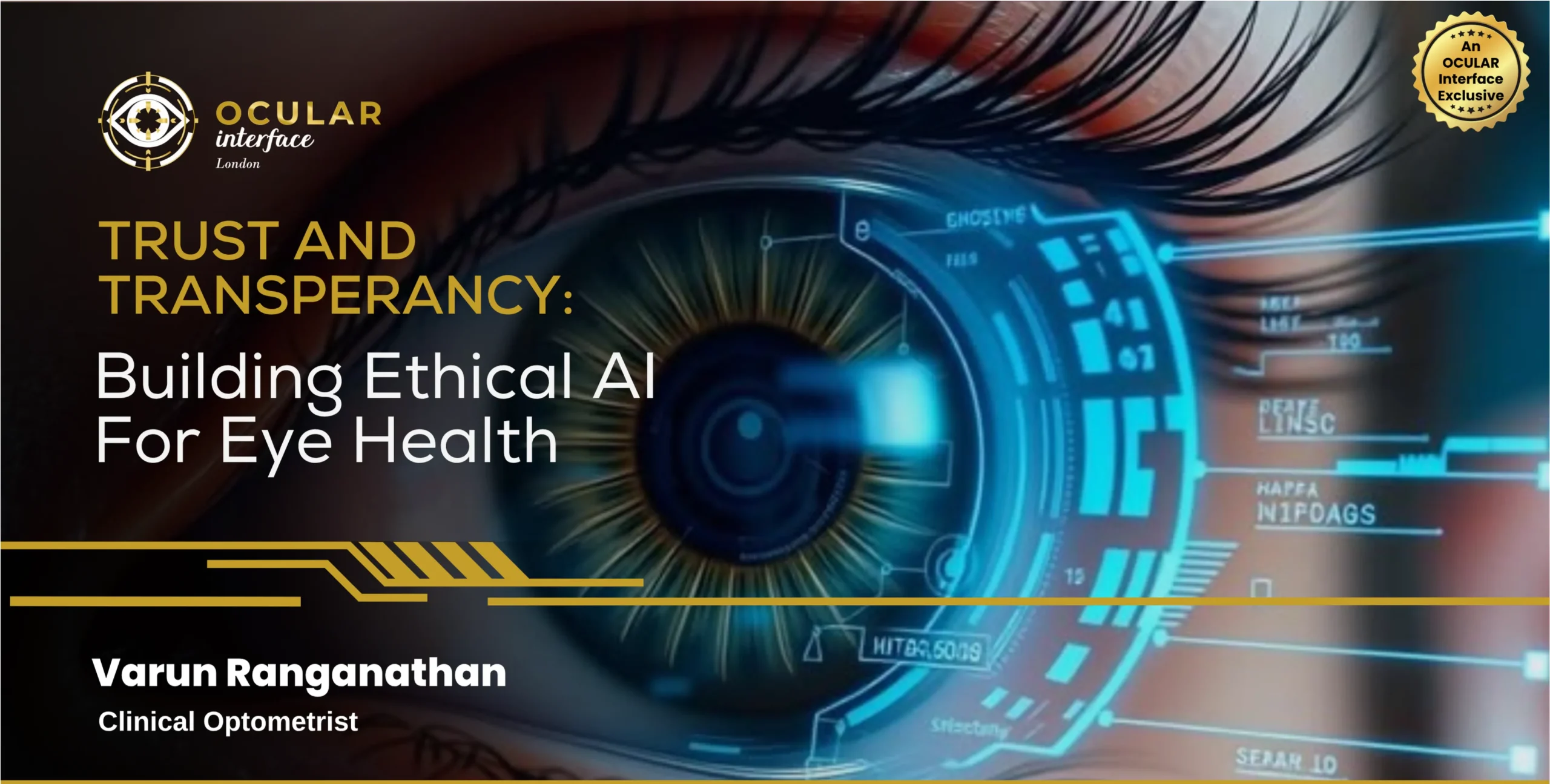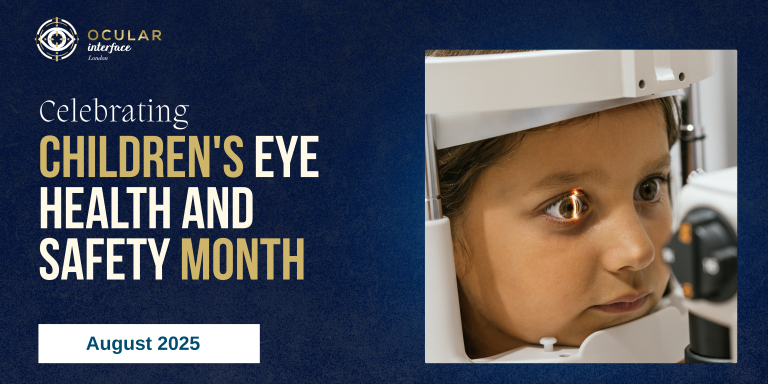Varun Ranganathan, MCOptom
Clinical Optometrist
An OCULAR Interface Exclusive
Synopsis:
As Artificial Intelligence (AI) becomes increasingly integrated into eye care, questions of trust, transparency, and ethical responsibility come to the forefront. This article explores the ethical dimensions of AI in vision health—addressing concerns around data privacy, algorithmic bias, informed consent, and clinical accountability. The blog also examines how developers, healthcare providers, and regulators can collaborate to ensure that AI tools in eye care uphold fairness, equity, and patient-centred values.
Introduction
Artificial intelligence (AI) is revolutionising eye care, offering powerful tools for early diagnosis, disease monitoring, and personalised treatment. Yet, as these technologies become integral to clinical practice, critical ethical questions must be addressed. Trust and transparency lie at the heart of these concerns, shaping how patients, clinicians, and developers navigate the evolving landscape of AI in vision care.
The Ethical Imperative in AI-Powered Eye Care
AI models can detect diabetic retinopathy, glaucoma, and age-related macular degeneration with impressive accuracy[4]. However, deploying these tools ethically requires more than technical excellence. Eye health, being deeply personal and essential to quality of life, demands AI systems that are not only effective but also fair, explainable, and secure. AI relies on vast amounts of data to learn and improve. In eye care, this includes retinal images, visual acuity tests, and sometimes genetic information. Ensuring this data is collected, stored, and used responsibly is vital. Patients must provide informed consent, understanding how their data will be used, who has access to it, and what protections are in place [2]. Clear communication fosters trust and respects patient autonomy.
Transparency and Explainability
One of the major concerns in ethical AI is algorithmic bias. If training data lacks diversity, AI systems may perform poorly on underrepresented groups, leading to misdiagnoses or unequal care [6]. In eye care, this could mean less accurate results for certain ethnicities or age groups. Developers must use diverse datasets and regularly audit models to ensure equitable performance across populations. AI models, especially deep learning systems, can be ‘black boxes’—producing results without clear reasoning [7]. This lack of explainability undermines clinician confidence and patient trust. Ethical AI should be interpretable: eye care professionals need to understand and explain how an AI system arrived at its recommendation. Transparency in model design and limitations enables better clinical integration and accountability [3].
Accountability and Clinical Oversight
Who is responsible when AI makes an error? While AI can support decision-making, the ultimate responsibility must lie with trained clinicians [10]. Ethical practice requires that AI be a tool—not a replacement—for medical judgment. Institutions should establish clear protocols defining AI’s role, responsibilities, and boundaries in clinical settings. Effective regulation ensures that AI tools meet safety, accuracy, and ethical standards before entering the market. Bodies like the FDA and MHRA are evolving their frameworks to keep pace with AI advancements [8][9]. Continuous oversight, including post-market surveillance, is essential to address emerging risks and maintain public trust. Trustworthy AI begins with ethical design and continues with education and communication. Developers must prioritise user-friendly interfaces and inclusive training data. Clinicians should receive ongoing education on AI tools, and patients should be engaged in conversations about how these technologies affect their care [1].
Conclusion
As AI reshapes the future of eye care, ethical considerations must guide its development and use. Trust and transparency are not optional—they are foundational. By addressing data privacy, bias, explainability, and accountability, the eye care community can harness the power of AI while safeguarding patient rights and enhancing care for all. At OCULAR Interface, we are committed to building a future where innovation and ethics go hand in hand.
References
- Jobin, A., Ienca, M., & Vayena, E. (2019). The global landscape of AI ethics guidelines. Nature Machine Intelligence, 1, 389–399. https://doi.org/10.1038/s42256-019-0088-2
- World Health Organization. (2021). Ethics and governance of artificial intelligence for health. https://www.who.int/publications/i/item/9789240029200
- European Commission. (2019). Ethics guidelines for trustworthy AI. https://digital-strategy.ec.europa.eu/en/library/ethics-guidelines-trustworthy-ai
- Ting, D. S. W., Pasquale, L. R., Peng, L., et al. (2019). Artificial intelligence and deep learning in ophthalmology. British Journal of Ophthalmology, 103(2), 167–175. https://doi.org/10.1136/bjophthalmol-2018-313173
- Li, Z., Keel, S., Liu, C., He, Y., & He, M. (2018). An automated grading system for detecting vision-threatening referable diabetic retinopathy. British Journal of Ophthalmology, 103(3), 356–360. https://doi.org/10.1136/bjophthalmol-2018-312598
- Obermeyer, Z., Powers, B., Vogeli, C., & Mullainathan, S. (2019). Dissecting racial bias in an algorithm used to manage the health of populations. Science, 366(6464), 447–453. https://doi.org/10.1126/science.aax2342
- Doshi-Velez, F., & Kim, B. (2017). Towards a rigorous science of interpretable machine learning. arXiv preprint arXiv:1702.08608. https://arxiv.org/abs/1702.08608
- S. Food & Drug Administration. (2021). Artificial Intelligence and Machine Learning (AI/ML)-Based Software as a Medical Device (SaMD) Action Plan. https://www.fda.gov/media/145022/download
- MHRA (UK). (2022). Software and AI as a Medical Device Change Programme. https://www.gov.uk/government/publications/software-and-ai-as-a-medical-device-change-programme
- Shortliffe, E. H., & Sepúlveda, M. J. (2018). Clinical decision support in the era of artificial intelligence. JAMA, 320(21), 2199–2200. https://doi.org/10.1001/jama.2018.17163










